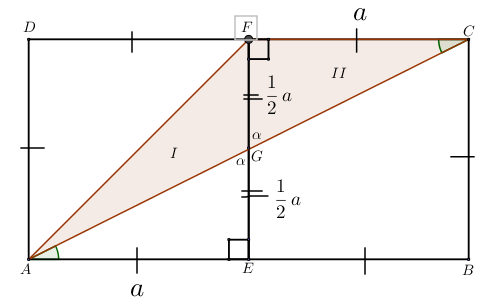Symmetry Destroyed 2
In rectangle A B C D , Δ A E C is formed by the midpoint E of D C and two rectangle vertices. The dashed line E F is then formed to split into two smaller triangles.
Which area is larger, Area 1 or Area 2 ?
Note : Try to prove this geometrically.
This section requires Javascript.
You are seeing this because something didn't load right. We suggest you, (a) try
refreshing the page, (b) enabling javascript if it is disabled on your browser and,
finally, (c)
loading the
non-javascript version of this page
. We're sorry about the hassle.
3 solutions

A G E triangle is congruent with F G C triangle. So F G = G E. The area of an A F G triangle is 2 1 × F G × A E and the area of the F G C triangle is 2 1 × F C × F G where F C = A E . So the area of triangle A G F = F G C .
In this case the intersection point between A C and E F is right in the middle of the rectangle. Let's call it as O. The △ A O E and the △ E O C have the same base E O and same height D E = E C . So, they have the same area. In this case O is the midpoint of A C but its position don't matters at all. If A O and O C don't make a straight line, the area of these triangles stays equal since they will still sharing the same base.
If the intersection of E F and A C is M , then E M ∣ ∣ D A . Since D E = E C , A M = M C . So E M is a median of △ A C E . Therefore the two areas are equal.